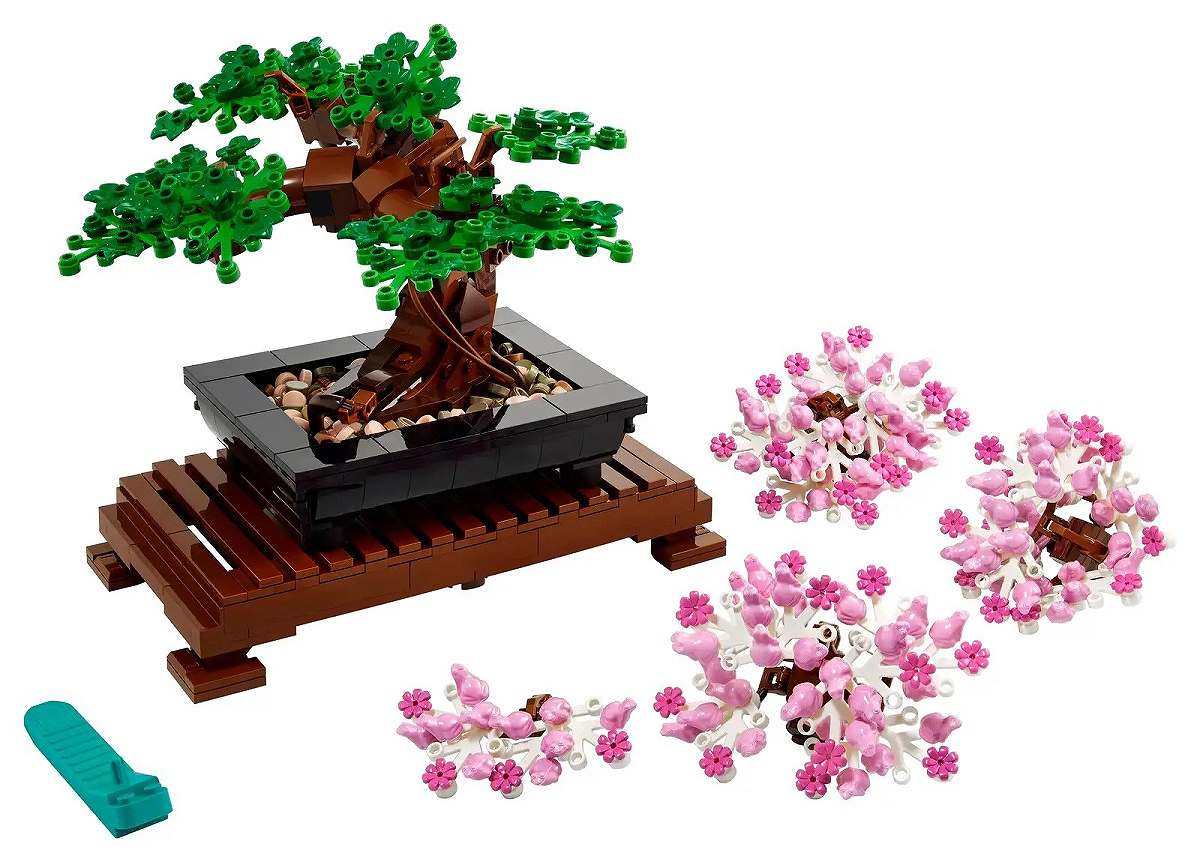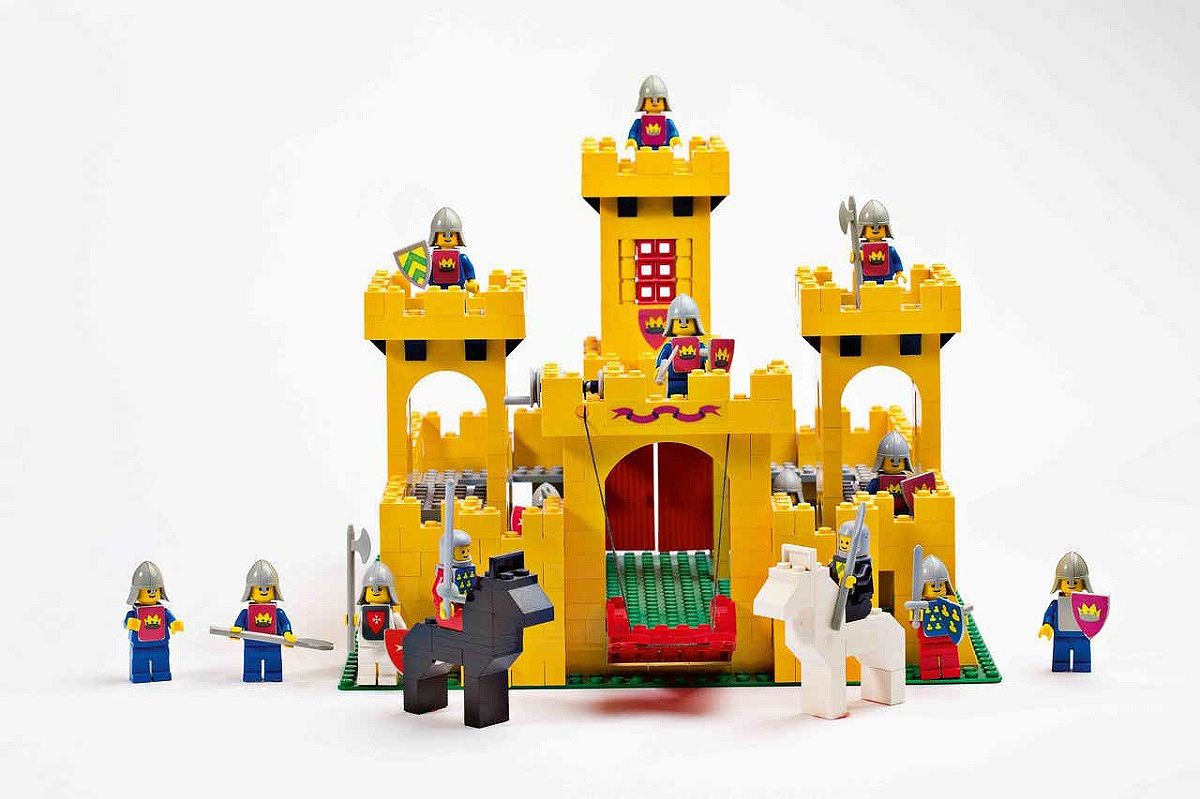
A bonsai tree Lego set uses pink frog-shaped pieces as flowers.
16:10 JST, September 16, 2023
Since modern Lego bricks debuted in 1958, their color scheme has undergone a transformation from just a handful to more than 110 at the peak in 2004. The palette has evolved, grown and shrunk over the decades.
When Lego started manufacturing bricks, it started small, colorwise. “These were very basic colors,” said Signe Weise, a corporate historian at Lego. The original brick colors, according to Weise, were red, yellow, blue, white and transparent.
If you counted every brick produced since 1958, most would be black, gray or white, but such a census obscures the colorful history of the palette. Using data from Rebrickable, a site that crowdsources information about Lego sets, The Washington Post analyzed the palette to explore what the color system says about the evolution of the company.
Jared Hinton, a Los Angeles-based site administrator for Rebrickable, has worked for more than five years helping to carefully catalogue and maintain the data.
“As the internet and interest in Lego colors has grown, so has our ability to preserve this information and create more accurate inventories,” Hinton said.
Lego bricks have appeared in nearly 200 different colors since 1958, including standard, transparent and glitter varieties.
At first, colors were limited. “Very few colors, very simple color system,” Weise said.
Following the 1978 introduction of Lego themes and the minifigures as we know them today, the palette began to ramp up. Colors were added between 1978 and 1989, but the total number of active colors in a year never exceeded two dozen.
In the 1990s, the color palette got a new addition: pink. “We introduced a couple of themes targeted to girls,” Weise said. “So that meant the introduction of more pastel-like colors, lighter greens and lighter pink colors.”
Lego’s product portfolio was expanding, which strained the company’s finances, Weise said. The number of colors in use tripled from 1990 to 2000, and the palette peaked in 2004 with more than 110 colors.
To steady the company, Lego reduced the number of bricks as well as the size of the color palette – down to about 60 in 2007. “We went from 14,000 different types of [bricks] to around 3,500,” Weise said.
The palette has grown slightly since 2007 to around 70 colors in 2022.
A more controlled color palette means designers have to work creatively within Lego’s color system, Weise said. One way designers do that is by reimagining pieces with new colors. For example, a frog piece appears in a bonsai tree set – but pink. The set contains many pink frogs, which sit on the branches of the tree in bloom, giving the appearance of flowers.
Similarly, an Avatar set includes turquoise bananas and purple carrots to build plant life. “You have to find new ways of using old things,” Weise said. “We’re making sure that [the bricks] are within the system and that they fit together with everything we have been doing.”
– – –

The yellow castle set from 1978.
Beginning in the 1960s, Lego grouped its products into a handful of categories, but it wasn’t until 1978 that Lego debuted the first major themes – Castle, Town and Space. Those themed sets form what is known to fans as the “classic three,” according to Hinton.
These themes each had a palette based on the colors of the time – early Castle sets included mostly yellow bricks while Town included a lot more white and red.
As Lego’s color system evolved and grew, so did the possibility for distinctive palettes. Among the themes that Lego launched in the 1990s were Star Wars and Belville, a category with elements including playgrounds, horses, castles and princesses. Both needed very different color profiles.
“There was this trend of pink toys [in the 1990s],” said Erica Weisgram, a professor at the University of Wisconsin at Stevens Point who researches gender development in children. “Pink got to be a designation of femininity.”
After the introduction of the pinks and pastels in the 1990s, the darker colors and primary colors in Lego’s palette seemed a lot more masculine by comparison, according to Weisgram.
Lego sets are still seen as gendered among parents. In a study commissioned by Lego and conducted by the Geena Davis Institute, researchers found that in an implicit bias assessment, 76 percent of parents said they’d recommend Lego for their sons compared to 24 percent who said the same of daughters.
In that same study, researchers shared recommendations – including about color – to help make Lego products more gender-neutral.
“Palette is a really important way that who a toy is for is communicated,” said Lisa Dinella, a professor at Monmouth University who studies children’s toy play along with gendered experiences. “Our science is really clear that children and consumers notice the color palettes, and that they know that those color palettes are associated with particular genders.”
In 2021, Lego committed to making its toys more gender-neutral.
– – –

A recent Lego Star Wars set includes some figures with natural skin tones.
The introduction of themes also marked the first time a Lego set included the yellow minifigure. The yellow minifigure introduced in 1978 was intended to be “ethnically neutral,” according to a Lego account of the history of the minifigure, and for decades almost all were yellow.
That changed in 2003 when Lego released a minifigure for Lando Calrissian, a Black Star Wars character. In that same account, authors write that he was the first minifigure in the Star Wars theme and among the first of all minifigures with natural skin tones.
Star Wars minifigures for human characters – like Luke Skywalker, for example – had been yellow up to that point. The decision to make Lando Calrissian’s skin brown was controversial among fans, according to Hinton, because the introduction of a Black minifigure in a world of yellow minifigures suggested that all yellow minifigures actually represented White skin tones.
Lando Calrissian was not the only minifigure released in 2003 with natural skin tones. That same year, Lego also released minifigures for several real-life people, including NBA stars Kobe Bryant, Chris Webber and Steve Nash. In 2004, Lego released a new color for light skin and updated minifigures in various franchises with natural skin tones.
“It’s important for us because using different colors, especially when we talk skin tones, is what enables us to represent more people,” Weise said. “More people, more children and more adults feel represented in our sets.”
Lego recently cited a desire among kids to see themselves better represented in their toys, which inspired a launch of a new set of characters for Lego’s Friends theme.
“Representation is always a really good thing for kids to be able to see. They want to see themself in the commercial. They want to see themself in this toy,” Weisgram said.
“Even though we have grown and the color palette has grown with us, we still know where we are coming from and what we’re going to stick with to keep the success going as well,” Weise said.
"News Services" POPULAR ARTICLE
-

American Playwright Jeremy O. Harris Arrested in Japan on Alleged Drug Smuggling
-

Japan’s Nikkei Stock Average as JGB Yields, Yen Rise on Rate-Hike Bets
-

Japan’s Nikkei Stock Average Licks Wounds after Selloff Sparked by BOJ Hike Bets (UPDATE 1)
-

Japanese Bond Yields Zoom, Stocks Slide as Rate Hike Looms
-

Japan’s Nikkei Stock Average Buoyed by Stable Yen; SoftBank’s Slide Caps Gains (UPDATE 1)
JN ACCESS RANKING
-

Keidanren Chairman Yoshinobu Tsutsui Visits Kashiwazaki-Kariwa Nuclear Power Plant; Inspects New Emergency Safety System
-

Imports of Rare Earths from China Facing Delays, May Be Caused by Deterioration of Japan-China Relations
-

University of Tokyo Professor Discusses Japanese Economic Security in Interview Ahead of Forum
-

Japan Pulls out of Vietnam Nuclear Project, Complicating Hanoi’s Power Plans
-

Govt Aims to Expand NISA Program Lineup, Abolish Age Restriction



























